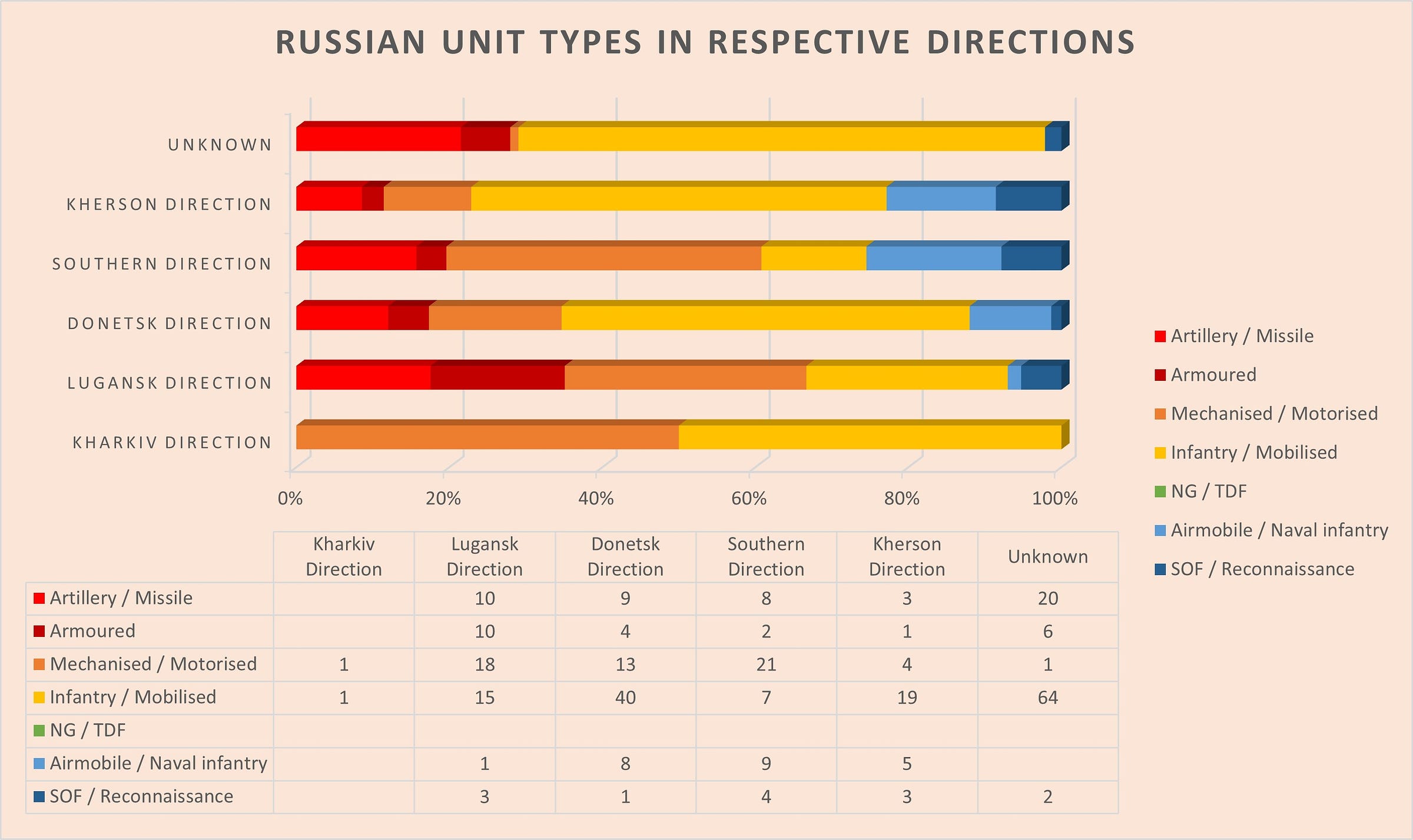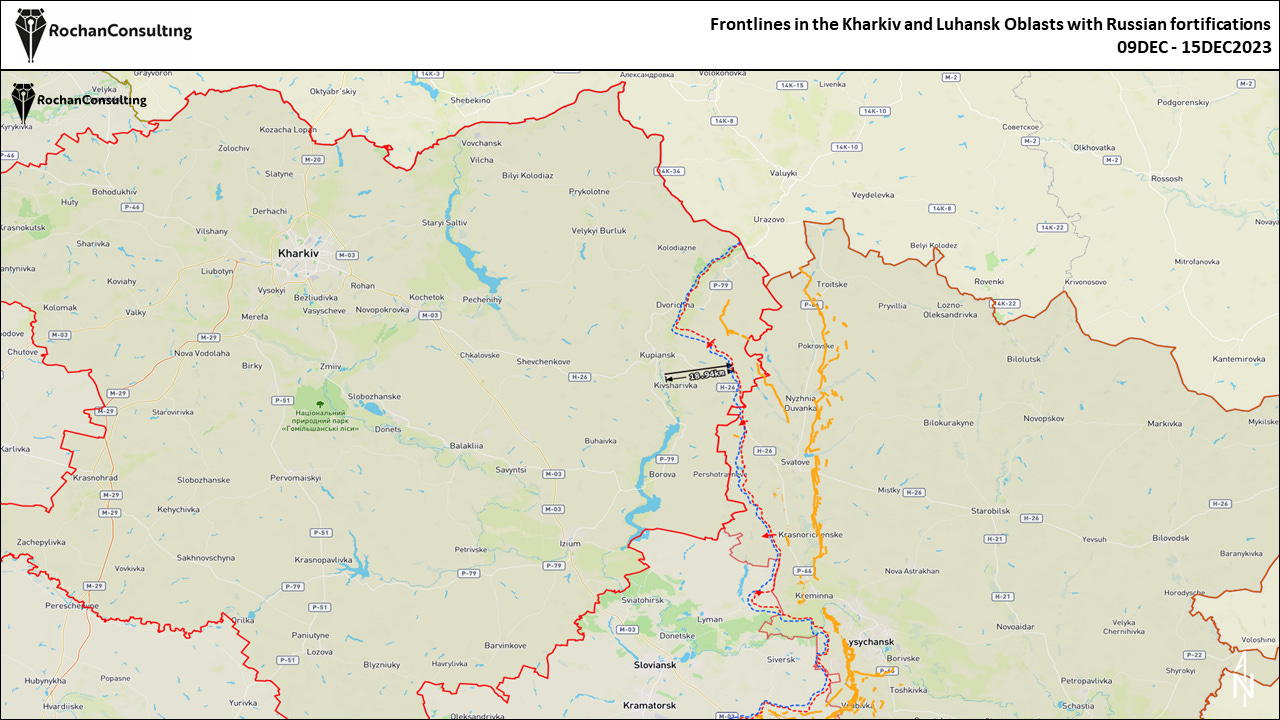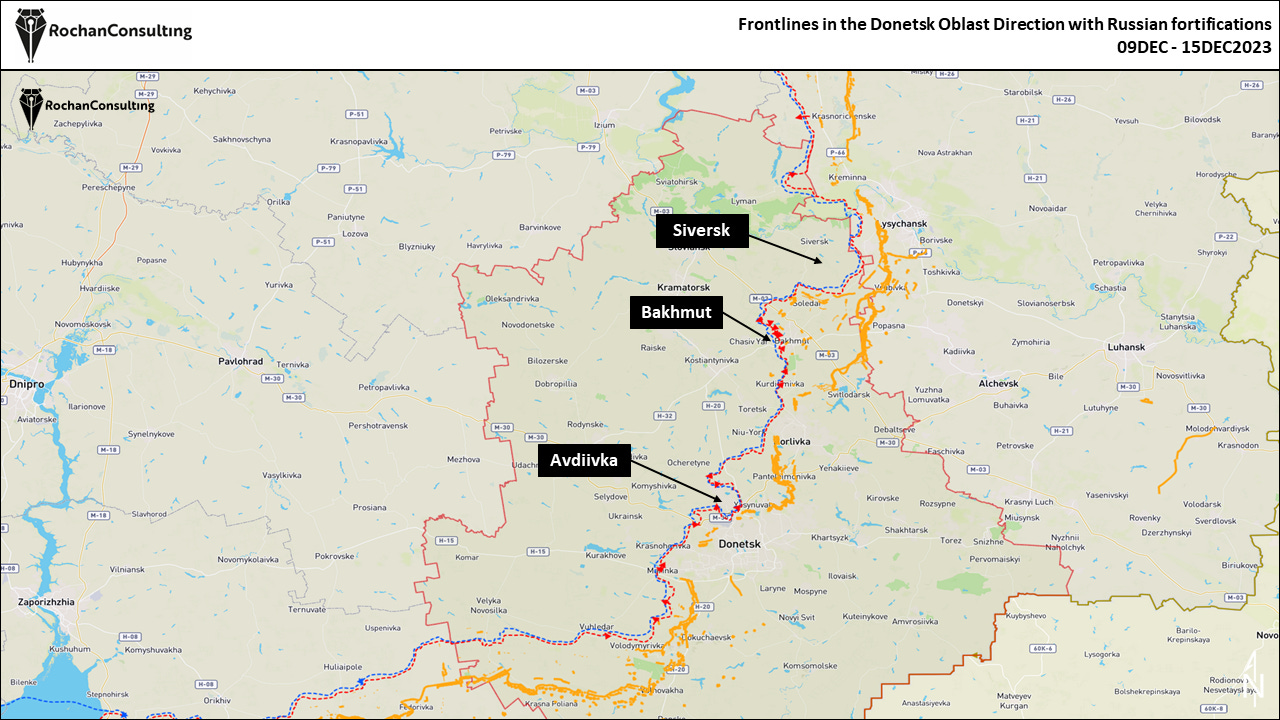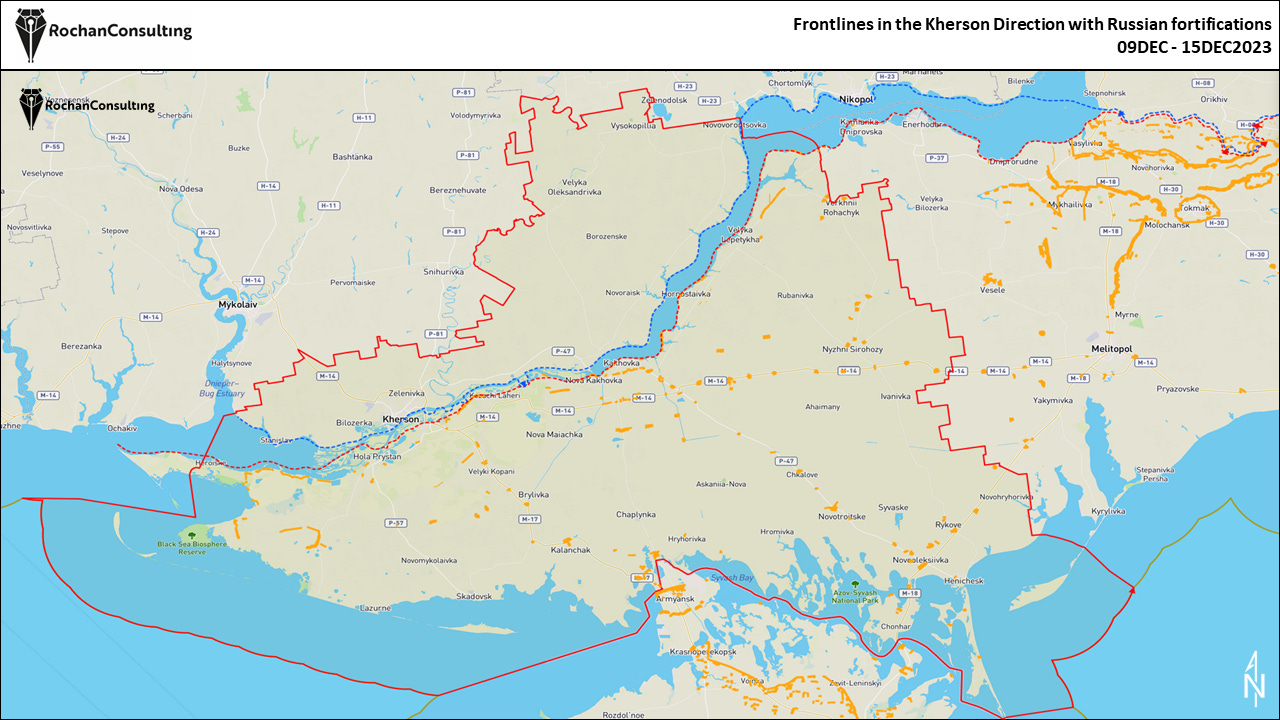Ukraine Conflict Monitor - 09 December – 15 December 2023 (Weekly update)
Please consider becoming a paid member of our Substack channel to support our work in providing high-quality information about the war in Ukraine and the political-military situation in Belarus. This will help us greatly to provide you with more content.
Key takeaways from last week’s developments:
Although the last week did not deliver any operational, let alone strategic, changes in Ukraine, Russian tactical advantages became more pronounced and visible, especially in the Donetsk Oblast, where they captured some terrain; Russians could have also reactivated axes, which thus far were ‘frozen’; Ukrainian posture is now defensive across the entire front;
Russians again attacked Ukrainian positions in the northern parts of the Luhansk Direction, attempting to inch towards Kupyansk; These efforts, however, were futile;
Russians reportedly advanced south of Siviersk in the Donetsk Oblast, an area which saw few ground attacks over the past months; Reports also indicated Russian forward movement northwest of Bakhmut;
Russians progressed southeast of Avdiivka and may have entered the town; They also advanced on the northern flank; To the south, Russians have probably captured the remaining parts of Mariinka;
The overall situation in the Southern Direction remained unchanged; both sides captured some territory; Notably, Russians seized some terrain just south of Robotyne;
Although Ukrainians maintained their presence on Dnipro’s left bank, they were under pressure from Russian units; Although these counterattacks did not deliver any results, Ukrainian posture in the Kherson was defensive;
Last week, Ukrainians noted increases in Russian Shahed, missile, and ground attacks; Raises in ground attacks corresponded with Russian territorial gains;

Executive summary
According to the Ukrainian General Staff (UGS), during the past seven days, the Ukrainian Armed Forces repelled 46 Russian ground attacks in the Kharkiv Oblast and Novoselivske in the Luhansk Oblast. In the Lyman axis, the UAF repelled 18 Russian attacks. In the Bakhmut, Avdiivka, Mar’inka and Shakhtars’ke axes, Ukrainians repelled 344 (271 last week) Russian attacks. The Ukrainian Forces repelled 23 (30 last week) Russian attacks in the Zaporizhzhia Direction.
The Ukrainian Air Force launched eight air strikes on the Russian concentration areas. At the same time, missile troops hit 16 concentration areas, four command posts, one artillery system, two fuels and lubricants depots and six ammunition depots.
Over the past seven days, Ukrainians liberated some five square kilometres (similar to the previous assessed period), while Russians captured more than 30 square kilometres, a sevenfold increase compared to two weeks ago. These gains did not translate into operational successes. However, the increase in the Russian territorial gains corresponds with the increased tempo and intensity of Russian ground attacks.
As stated in the previous UCM issues, the Ukrainian posture was increasingly defensive across the entire front. Last week, we noted that Dnipro’s left bank was the only exception. This week, we would like to change this assessment. Based on Ukrainian and Russian reports, geolocated images, and videos, we conclude that Ukrainians are on the defensive along the entire frontline.
Their positions in Krynky in the Kherson Oblast are very susceptible to Russian air and artillery fires and, therefore, very vulnerable. Kyiv’s ability to support its units to defend the area is limited, let alone offensive operations towards even neighbouring settlements. By some accounts, the Ukrainian presence in Krynky is Bakhmut 2.0
In the Bakhmut area, Russians now enjoy a 4/5:1 artillery advantage over Ukrainians, a ratio that was 1:1 during summer. Based on our conversations in the Bakhmut area in November, this change in ratio did not necessarily come due to the increased number of Russian artillery strikes. Since the summer, Ukrainians fired fewer rounds as the West underdelivered on their promises and previously agreed schedules. As a result, Ukrainians suffer from shell hunger AND they need to conserve ammunition in case an increased rate of fire is immediately needed.
Last week’s reports also suggested that Russians commenced attacks in areas which were “frozen” for months. This could indicate that Russians could open a new axis of advance over the coming weeks, further exacerbating Ukrainian defence choices.
To sum up, our forecast for the following months remains unchanged. Moscow has the preponderance of firepower and equipment and will continue ground attacks in the Donetsk Oblast, an area prioritised by the Russian political-military command. Ukrainians will face very difficult months ahead as an insufficient number of artillery shells and underdeveloped fortifications will limit their defensive potential. The loss of terrain, especially around Robotyne (including the village itself), is highly likely.
Noteworthy events pertaining to the war
Monday (11DEC)
The British Ministry of Defence informed that the British and Norwegian Navies launched a maritime support initiative for Ukraine (Maritime Capability Coalition) and will provide two Sandown-class minesweepers to Ukrainians.
The Mayor of Dorohusk, Wojciech Sawa, withdrew the permit for protests at the Polish-Ukrainian border, practically ending the protests in this area. His decision was, however, appealed, and on Saturday (16DEC), a court overturned the mayor’s decision.
The Russian Central Election Commission informed that presidential elections (15-17MAR24) would also be held in occupied Ukrainian oblasts (Donetsk, Lugansk, Zaporizhzhia and Kherson).
Tuesday (12DEC)
The United States imposed sanctions against more than 250 people (or entities) from China, Turkey and the United Arab Emirates for allowing Russia to evade already imposed sanctions.
The Ukrainian representatives confirmed the arrival of 11 Gurkha armoured medical vehicles from Canada.
The British Minister of Defence Grant Shapps said the UK would provide 23 amphibious boats and 20 Viking armoured vehicles (also amphibious) to Ukraine.
The US Department of Defence announced a new military aid package for Ukraine. It is worth USD200 million and includes air defence components, AIM-9M, HIMARS and HARM missiles, 105 and 155-millimetre artillery rounds, and AT-4 and TOW launchers with more than 4 million small rounds of ammo. The demolition materials and other equipment were also included.
Russian hackers (likely the “Solntsepek” group) conducted a cyber-attack against the biggest Ukrainian mobile network operator, Kyivstar. It could affect 10,000 computers, over 4,000 servers and all cloud storage and backup systems.
Wednesday (13DEC)
The Norwegian Prime Minister Jonas Gahr Stjøre announced plans to provide Ukraine with additional assistance in air defence and new financial support for the health, education and defence industries.
The Slovakian Prime Minister Rober Fico claimed he would not interfere with Ukrainian negotiations to join the European Union. However, he stressed that he considers Ukraine “completely unprepared” for such a step.
Thursday (14DEC)
On 14DEC, the Swedish Government approved a financial support package for Ukraine. It is worth EUR124 million and will be used to support civil infrastructure.
Russian President Vladimir Putin informed that 617,000 military personnel were directly involved in the Russo-Ukrainian conflict (in Ukraine). Some 244,000 were in combat zones.
The Danish MoD announced the 14th military aid package to Ukraine. Worth USD1 billion, it includes tanks, air defence systems, UAVs, and ammunition. Moreover, Denmark allocated USD256 million to purchase defence industry products to meet Ukrainian needs.
The European leaders decided to open European Union membership talks with Ukraine.
The President of the European Commission, Ursula von der Leyen, informed that the European Union was preparing a EUR1.5 billion tranche of financial aid to Ukraine. It will be transferred in the “coming days”.
Ukraine battle map
Please click here to access our interactive map and click here to access the archive.
The situation at selected axes and directions
Below, the reader will find information about Russian and Ukrainian units deployed in respective directions. We attach medium confidence to this data. The list is not exhaustive, either. However, the reader should know that we change/update Russian and Ukrainian ORBATs daily. Secondly, the unknown column shows the number of units whose current whereabouts are unclear. There are a lot of units uncommitted on both sides as well.
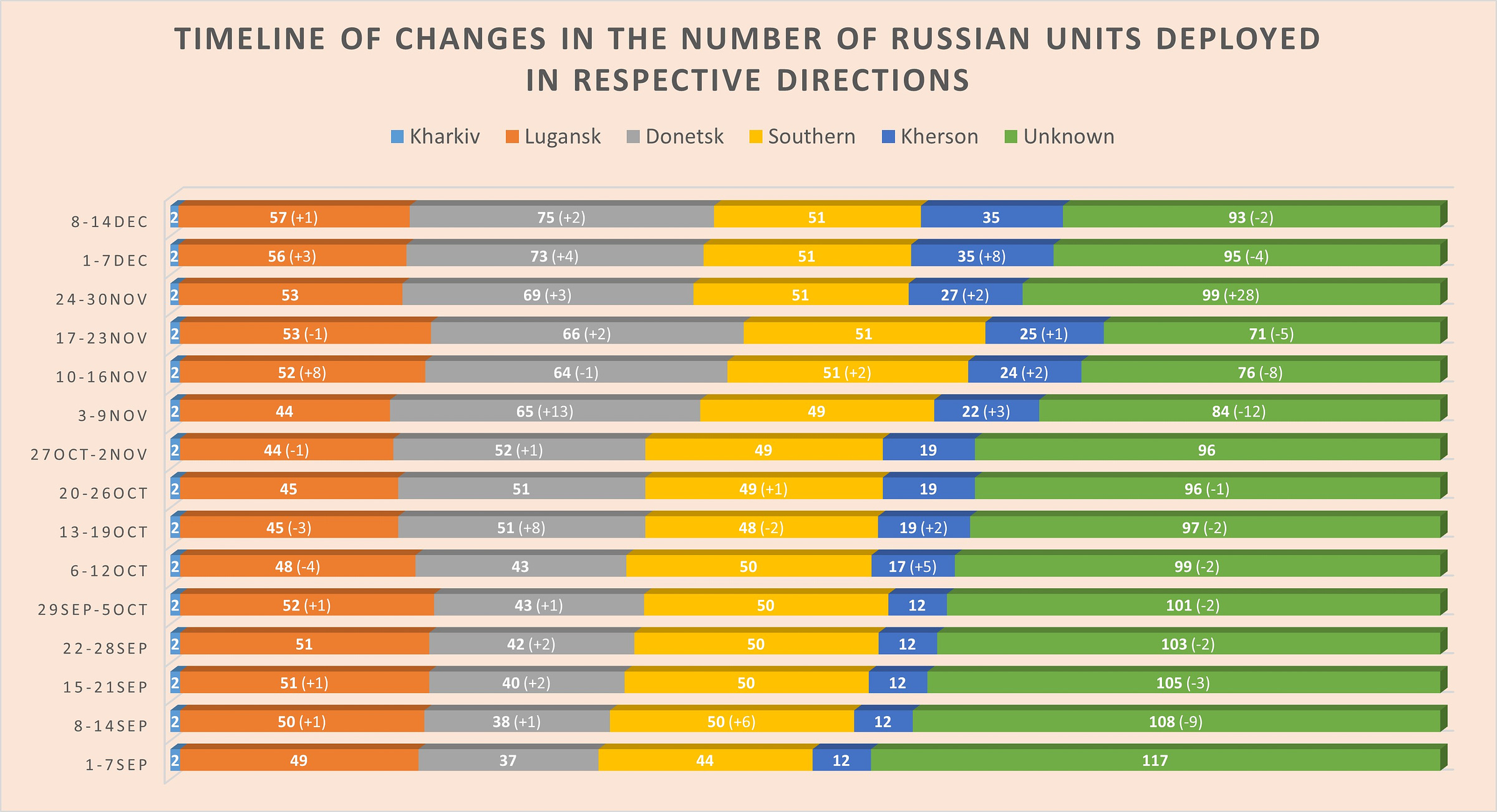
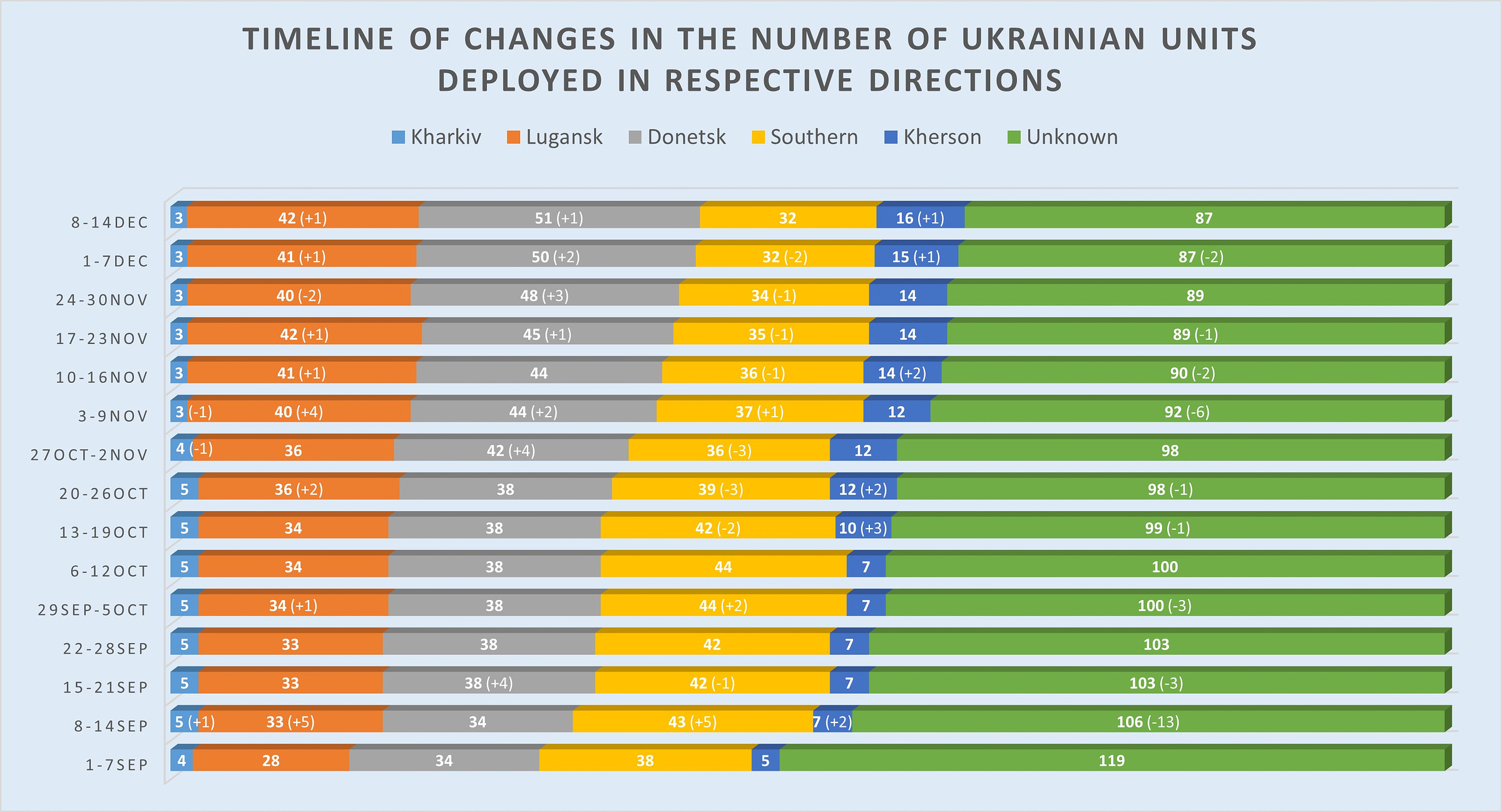
Last week, Ukrainians continued efforts to strengthen the defences in the Lugansk and Donetsk directions.
To this end, from the Kharkiv direction, Ukrainians deployed elements of the 60th Mechanised Brigade to the Kreminna axis. They also brought elements of the 210th Separate Rifle Battalion, most likely to the Svatove axis.
Regarding Donetsk Oblast, the 46th Air Assault Brigade from the Robotyne area (Southern direction/Orikhiv axis) was deployed near Marinka (Donetsk direction/Donetsk axis). In turn, elements of the 88th Mechanised Brigade appeared on the Orikhiv axis.
Based on open-source reports, we adjusted the position of the 3rd Special Purpose Regiment, which was moved from Donetsk to the Horlivka axis of the Donetsk direction. We also repositioned the 122nd Territorial Defence Brigade to the Kherson direction (its earlier position was unknown).
Last week, we noticed limited redeployments engaging Russian military formations and units.
Available data confirmed the arrival of the 119th Airborne Regiment (106th Airborne Division) to the Bakhmut axis of the Donetsk direction. We have also placed the 283rd Motor Rifle Regiment (144th Motor Rifle Division, 20th Combined Arms Army) on the Kreminna axis.
We also added the 346th Spetsnaz Brigade to the map (Donetsk direction/Bakhmut axis).
Kharkiv Oblast Direction
(This section only covers ground developments in the northern Kharkiv Oblast and Russian artillery strikes across the entire region).
No significant changes occurred in the Kharkiv Oblast over the past seven days.
According to Oleh Synehubov, the head of the Kharkiv Oblast administration, Russians continued to shell civilian infrastructure in the Kharkivsky, Bohodukhivsky, Kupyansky, Izuimsky and Chuhuivsky districts. In particular, Russians shelled Udy, Stohnii, Kozacha Lopan, Veterynarne, Vovchansk, Dvorichna, Synkivka, Petropavlivka, Ivanivka, Berestove and Kupyansk-Vuzlovyi, Hraniv, Budarky, Fiholivka, Kyslivka, Tabaivka, Krokhmalne, Chuhunivka and Kupyansk.
No information about Russian border infiltration activities appeared in open sources. However, we assess that such actions are regular and constant.
Luhansk Oblast Direction
Russians continued to exert pressure on Ukrainian forces in the northern part of the Luhansk Direction. Still, these ground attacks did not deliver any confirmed frontline changes over the past week.
That said, attacks in this part of the front appeared subdued during the weekend. Both sides’ sources reported positional battles near Lyman Druhyi, Lyman Pershyi, Ivanivka and Synkivka, but without an impact on the frontline. Also, no changes occurred further east, near Orlyans’ke and Pershotravneve.
On Monday (04DEC), Ukrainian sources reported that although no frontline changes occurred, Russians were deploying more reserves to keep the intensity of fighting high. On the same day, a Russian source claimed that Russian troops advanced near Synkivka. The source said that the Russian troops controlled the northern outskirts of the village. Russian units also conducted “active actions” to the south, forcing the Ukrainians to expend reserves. On Tuesday and Wednesday (05-06DEC), Russian units reportedly progressed deeper into Synkivka. The Russian source asserted that Ukrainians had severe problems holding positions near Synkivka and Petropavlivka. Ukrainians started constructing defensive lines outside of the former village. At the very least, this indicates preparations for the pullback from the village in the worst-case scenario. But it could also be a preparation for a planned withdrawal. The Ukrainian blogger claimed on Wednesday (06DEC) that the Russians conducted an assault near Lyman Pershyi (no detailed information was provided). Near Ivanivka, the Ukrainian Forces once again managed to recapture lost positions.
So far, these developments have not been confirmed by independent sources.
Moving further south, neither Russian nor Ukrainian sources reported changes between Krohmalne and Chervonopopivka.
On Sunday (03DEC), the Ukrainian source claimed that the Russians had captured some Ukrainian positions near Terny during the week. On Tuesday, one Russian source stated that Russian troops managed to advance about one kilometre west from their positions, thus placing them some 4 km from the village.
Neither Russian nor Ukrainian sources reported changes near Nevske, Torske and Yampolivka.
No significant developments occurred in the Kreminna area. Positional battles continued near Serebryansky forest and Dibrova. Neither Russian nor Ukrainian sources reported changes.
The same goes for Bilohorivka.
According to Sergey Zybinskyi, a Russian Western Group of Forces Spokesperson, during combat actions in the Kupyansk direction, Russian units supported by aviation and artillery repelled 14 Ukrainian attacks by assault groups from the 43rd, 60th Mechanised and 57th Motorised Infantry Brigades near Ivanivka and Synkivka. Russians also claimed to have destroyed three mortars, a supply point and the Bukovel anti-drone electronic warfare system near Kyslivka, Berestove and Synkivka. Russian artillery and aviation also reportedly hit manpower and equipment concentration areas of the Ukrainian 14th Mechanised Brigade and 25th Airborne Brigade near Synkivka and Berestove. They also claimed to have disrupted the rotation of the 57th Motorised Infantry Brigade and 44th Mechanised Brigades near Lake Lyman and Vyshneve(?). The Ukrainian 113th Territorial Defence Brigade’s ammunition depot was destroyed near Lyptsi in the Kharkiv region.
According to Aleksandr Savchuk, a Russian Centre Group of Forces Spokesperson, in the Lyman direction, Russian units supported by artillery repelled seven Ukrainian attacks by elements of the 60th, 63rd, and 67th Mechanised Brigades near Yampolivka and Dibrova. The Ukrainian concentration areas of the 63rd Mechanised Brigade and 12th Azov Special Forces brigade units were also hit near Yampolivka and Serebryansky forest.
(The data on Russian fortifications comes from Black Bird Group/DefMon)
Donetsk Oblast Direction
The Russian forces continued their offensive in the Bakhmut and Avdiivka directions. They were successful in certain areas but without significantly impacting the front line.
Starting from the northern parts of the front, on Monday (11DEC), one Ukranian source claimed that Russian forces achieved some success near Vesele. It is unclear what this development involved. But the frontline in this area has been frozen for months. Any territorial control changes could indicate further Russian attacks over the coming days and weeks. However, so far, no other source confirmed Russian progress, and neither side reported any further attacks near the village.
On Wednesday (13DEC), the Russian source said that Russians pushed Ukrainian troops back near Rozdolivka. The source added that this area had also been reactivated. Another Russian source stated the following day that (14DEC) Russian troops began an offensive towards Siversk from the Sakko and Vantsetti area. No further information was provided
Above, we mentioned Syrskyi’s comments on the situation near the front in the Luhansk Oblast, he also shared his thoughts about the situation in the Donetsk Oblast. Syrskyi stated that the Russians were directing significant efforts toward the Bakhmut direction, especially on the northern and western flank. To this end, they used airborne units, special forces formations and the Northern Fleet’s 200th Separate Motor Rifle Brigade. He stated that Russian casualties in the eastern part of the front (Donetsk Oblast) were about eight times higher than those of Ukrainian units. Our order of battle map shows the Russian 98th Airborne Division, the 200th Motor Rifle Brigade, and the 346th Spetsnaz Brigade deployed near Bakhmut.
On Saturday (09DEC), the Russian source claimed that Russian units were operating on the outskirts of Bohdanivka. They also launched attacks on Ukrainian positions near Hryhorivka. However, no detailed information about these developments was provided, although another Russian source assessed that on the same day, all Russian attempts in these areas were unsuccessful.
On the other hand, Ukrainian sources said that Russian infantry groups and equipment were spotted east of Bohdanivka, indicating some Russian forward movement.
The Russians also conducted successful assault operations near Khromove. In addition, the Russian troops made progress between Bakhmut and Ivanivske. The 144.0 height was reportedly captured in early December.
Yet, Ukrainians assessed that further Russian progress had been halted, although there is an expectation that Russians will attempt to advance from Bakhmut to Ivanivske.
On Monday (11DEC), the Russian journalist claimed that Russian troops achieved significant tactical successes near Khromove and Bohdanivka, confirmed by Ukrainian sources. The source said that, thus far, an offensive was underway against the main Ukrainian fortification lines near Chasiv Yar.
The same (Ukrainian) source added that the Russian assault continued towards Bohdanivka and Popivsky forest, where the already critical situation deteriorated further. They named Ukrainian operations in the area “the Chasiv Yar Defence Operation”. Russians maintained the initiative mid-week and reportedly captured a section of the Hryhorivka – Bohdanivka road. On Wednesday (13DEC), the Russian source said that Russian troops advanced near Ivanivske. They also reached the outskirts of Bohdanivka, which was the key to the UAF’s main fortification near Bakhmut in Chasiv Yar. Ukrainian sources did not report changes.
No changes occurred in Bakhmut.
On Saturday (09DEC), the Russian source stated that supported by artillery, Russian troops launched attacks and managed to enter the dominant heights northwest of Klishchiivka. On Sunday (10DEC), another Russian source claimed that Russian troops continued to expand the front ledge north of Klishchiivka, something, which Ukrainian sources did not report at all. On Tuesday (12DEC), the Russian source claimed that Russian forces continued to push through the Ukrainian defences north of Klishchiivka. The Ukrainian bloggers added that on Tuesday (12DEC), the battles for height 215.7 continued, and Ukrainian forces still managed to hold their positions. However, the Russians had occupied most of the Ukrainian trenches nearby. On Wednesday (13DEC), the Russian journalist claimed that Russian troops advanced near Klishchiivka. This statement could have been the reiteration of previously made gains.
Neither Russian nor Ukrainian sources reported changes near Kurduymivka and Ozaryanivka.
On Monday (11DEC), the Ukrainian source claimed that elements of the 24th Separate Mechanised Brigade had retaken the Gagarin mine site. The Russian journalist claimed that on Tuesday (12DEC), the Ukrainian forces were attacking the slag heaps northwest of Horlivka in an attempt to force the redeployment of some Russian troops to the area. On Thursday (14DEC), the Russian source said that Russian forces recaptured previously lost height north of Horlivka.
On Tuesday (12DEC), Brigadier General, Commander of the Tavria (Zaporizhzhia and Kherson Oblasts) Operational and Strategic Group of Forces, Oleksandr Tarnavskyi, claimed that on Sunday (10DEC), Russians launched an offensive in the Avdiivka and Mariinka axes. Mechanised and armoured attacks were supported by aviation and aircraft equipped with glide bombs. Near Avdiivka, the Russians were trying to advance both in the city’s north and south. They were also active near Mariinka, Krasnohorivka and Novomykhailivka. On Monday (11DEC), 42 Russian attacks were repelled east of Novobakhmutivka, south of Severne and Tonenke and in Avdiivka, Pervomaiske and Nevelske. On Sunday (10DEC), in the Avdiivka sector, 49 attacks were repelled, and 11 Russian tanks and 15 other armoured vehicles were destroyed.
According to Russian sources, on Sunday (10DEC), the attackers achieved some tactical successes behind the railway line near Stepove. However, no detailed information was provided. Another Russian source claimed that on Sunday (10DEC), the Russian units entered the city limits of Avdiivka from the north, and the battles occurred on the city’s outskirts in the residential area. Ukrainian sources did not report changes/attacks. On Wednesday (13DEC), the Russian journalist reiterated that the Russian units continued to attack near the Avdeyevskiy Coke Plant, Stepove and Novokalynove. The source said no changes had occurred on the line of contact in this area. Russian sources did not report changes.
Neither Russian nor Ukrainian sources reported changes near Ocheretyne.
In Avdiivka alone, the situation remained unchanged as the Russians continued to shell the city heavily.
On the southern flank, according to the Russian source, on Sunday (10DEC), Russian troops purportedly seized Ukrainian positions in the St. “Vynohradnyky” area near the Industrial Zone. This was the first indication that Russians progressed south towards the city. Ukrainian sources, however, did not report any changes.
However, Russians maintained attacks near Pervomaiske, Tonenke and Sjeverne.
The Ukrainian sources claimed on Monday (11DEC) that in recent days, the Russians have been conducting assault operations south of the Avdiivka industrial zone, in Sjeverne, Tonenke, Pervomaiske and east of Nevelske. The density of the attacks “was enormous”, which resulted in Ukrainians losing some positions. However, they claimed that most attacks have been repelled. The Russian source asserted that on Monday (11DEC), Russians broke through the Ukrainian defence line north of the St. “Vynohradnyky” and entered the outskirts of Avdiivka near Kolosova Street. Russian troops were also building up pressure on Sjeverne, Tonenke and Pervomaiske.
Another Russian source said that the primary objective is to break through towards the Khimik in Avdiivka to cut off the UAF units in Avdiivka. However, Ukrainians reportedly concentrated over 40 battalions from eight brigades near the city. The Ukrainians have also increased the number of artillery and FPV drone strikes in the area. On Tuesday (12DEC), the Ukrainian blogger claimed that over the last three days, Russians had conducted assault operations in at least 16 places in the Avdiivka axis. The source confirmed that Russian units captured the industrial zone, and the battles had already occurred between Yasynovs’kyi and Kolosova Street. The industrial zone is elevated relative to the city, so its loss could hinder Ukrainian movement in the city. The Russian source claimed that on Tuesday (12DEC), despite challenging weather conditions, Russian troops were active near the industrial zone, where the Ukrainians were pulling in new reinforcements from other parts of the front. On Wednesday (13DEC), the Russian source claimed that Russian troops had taken new positions near the industrial zone southeast of the Ukrainian stronghold.
Neither Russian nor Ukrainian sources reported changes near Opytne.
According to the Ukrainian blogger on Sunday (10DEC), the Russian troops managed to advance on the western outskirts of Mariinka. The Ukrainian source also assessed that the situation near Novomykhailivka continued deteriorating.
The same source further mentioned that Ukrainian defensive operations faced complications due to the Russians having achieved artillery superiority since the (end?) summer. Consequently, they succeeded in destroying a significant portion of Ukrainian positions.
A Ukrainian soldier claimed that as of Sunday (10DEC), the UAF controlled 30% of Mariinka, which is unlikely to be correct. The Russian source confirmed on Sunday that Russian troops advanced further to the west and raised a flag over the city. However, the Ukrainian troops were still on the outskirts of Mariinka. Russian units were also advancing north of the Mariinsky reservoir. However, no detailed information was provided about this axis. The Ukrainian blogger claimed that on Monday (11DEC), Russians advanced in the southern part of Mariinka and near Novomykhailivka. The source said that the situation near Novomykhailivka continued to deteriorate. In addition, the Russian troops became more active near Krasnohorivka.
On Tuesday (12DEC), the Russian journalist claimed that the battle for the town was nearing completion, which would happen when the north of the reservoir was cleared. Ukrainians were also reportedly withdrawing towards Heorgiivka. However, the UAF had time to mine the approaches to the village and develop and man a reserve line. Nevertheless, the source said that battles continued north of the Mariinsky Reservoir as of Tuesday. About two per cent of the city’s territory remained under the UAF control. The Ukrainian blogger confirmed that on Tuesday (12DEC), the Russian troops captured the southern part of Mariinka as well. In addition, the Russians made progress further south of Mariinka and north of Novomykhailivka.
On Wednesday (13DEC), the Brigadier General, Commander of the Tavria (Zaporizhzhia and Kherson Oblasts) Operational and Strategic Group of Forces, Oleksandr Tarnavskyi, the Russians were being held back near Novomykhailivka and Krasnohorivka. Near Mariinka, Russians were amassing forces for further assault operations. They also continued to spread information and provocations about the alleged complete capture of the town. The defence of Maryinka continued, he added.
On Thursday (14DEC), the Russian journalist claimed that apart from assaults in Mariinka, Russians also became more active to the south, towards the significant Ukrainian stronghold in Pobjeda. However, no further information was provided about these developments.
On Monday (11DEC), the Russian journalist claimed that Russian units tried to attack in the Vuhledar direction but were unsuccessful.
According to Vadym Astafiev, a Russian South Group of Forces Spokesperson in the Donetsk direction, Russian units repelled 31 Ukrainian attacks near Bilohorivka, Ivanivske, Hryhorivka, Shumy, Kurdyumivka, Bohdanivka, Vasyukivka, Andriivka, and Klishchiivka. They also inflicted fire damage on the 22nd, 93rd Mechanised Brigade and 79th Airborne Assault Brigade near Mariinka, Kurdyumivka, Andriivka and Klishchiivka.
Southern Direction
Last week did not deliver any changes in this direction. Ukrainian small-unit attacks were repelled. However, increasing Russian offensive activities are noteworthy, especially around Robotyne.
No changes occurred in the Velyka Novosilka axis.
According to the Russian journalist on Monday (04DEC), the Russian troops tried to attack from the southwest towards Staromaiorske but were unsuccessful.
Neither Russian nor Ukrainian sources reported change near Urozhaine, Pryyutne, and Levadne.
Both sides were more active in the Orikhiv axis.
On Sunday (03DEC), Ukrainians stated that Russians were conducting a series of offensive actions to stop Ukrainian attacks. However, no further information about this development was provided from the Ukrainian side.
It is possible that these attacks pertained to Russian assaults west of Robotyne from the direction of Novoprokopivka and Verbove, which Russians reportedly conducted on Sunday.
Another Russian source added on the same day that Russian units were counterattacking with small groups with no intention of achieving a breakthrough. The source added that whereas in the summer, the Ukrainians threw up to several companies with armoured vehicles into the battle to advance, now it was two motorised infantry platoons per assault.
The assessment of a lack of the need to achieve a breakthrough contrasts with the Ukrainian soldiers’ description of the current situation. Also on Sunday, a Ukrainian soldier claimed that as a result of Russian attacks, the UAF “almost lost” Robotyne. The Russians reached the first streets but were pushed back. Russians are, therefore, determined to retake the city, and they will likely attain this objective in the near term.
On Monday (04DEC), the Ukrainian blogger claimed that the Russians attacked Ukrainian positions west of Verbove and achieved partial success, but the scale of the advance is unclear. The Russian source claimed on Monday that the UAF tried to counterattack west of Robotyne village. Supported by artillery and drones, they also conducted offensive actions near Novoprokopivka and northwest of Verbove, but in both cases, they were unsuccessful. On Wednesday (06DEC), the Ukrainian blogger claimed that the Russians were conducting reconnaissance-by-force west of Robotyne, and convoys of vehicles were already moving in to secure Russian positions, indicating that some progress had been made.
On the back of the stories about Russian advances near Orikhiv, the Russian source stated on Tuesday (05DE) that Russian forces captured the Myrne. But so far, this information remains unconfirmed.
Neither Russian nor Ukrainian sources reported changes near Pyatykhatky.
According to Oleg Chekhov, a Russian Eastern Group of Forces Spokesperson, in the South-Donetsk direction, Russian fixed- and rotary-wing aviation and artillery struck temporary deployment sites of the UAF 58th Motorised Infantry Brigade and 79th Air Assault Brigade near Novomykhailivka and Vuhledar and the 72nd Mechanised Brigade near Vuhledar, and the 118th Territorial Defence Brigade near Makarivka. Russians also hindered rotation Ukrainian rotation attempts of the 58th Motorised Infantry Brigade, the 118th, and the 128th Territorial Defence Brigade near Staromaiorske and Urozhaine.
Kherson Direction and Crimea
Ukrainians maintained their presence on Dnipro’s left bank but could not expand the bridgehead. In the meantime, Russians continued to prepare for a counterattack to dislodge Ukrainians and push them back over the river.
Oo changes occurred on the Dnipro’s left bank during the weekend (02-03DEC). Ukrainians attempted to push south of Krynky. However, Russian use of drones, artillery and FAB-500s and FAB-1500s bombs prevented any Ukrainian gains.
On Monday (04DEC), the Russian journalist claimed that during the night, two Ukrainian assault groups from the 38th Marine Brigade took up positions south of Krynky, indicating a slight advance of the Marines to the south. The source, however, added that as a result of artillery and mortar, Ukrainian groups dispersed and were unable to concentrate their efforts.
Although there is an understanding that the overall situation in the region did not change, freezing temperatures and the freezing of the Dnipro riverbed may improve Ukrainian logistics and translate into an increased number of Ukrainian ground attacks.
Indeed, on Sunday (03DCE), the Russian source said that the Ukrainian side had already started transferring the 37th Marine Brigade units on the left bank. The unit had not previously participated in the battles and was fully manned. On the one hand, it is also possible that the deployment of the brigade could indicate significant Ukrainian losses and the commencement of rotation of already deployed units. Regardless, already on Monday (04DEC), Russians noted the increased intensity of Ukrainian attacks.
On Wednesday (06DEC), the Russian source claimed that Russian troops continued to actively fire at Ukrainian positions in and around Krynky. However, the overall situation remained unchanged. The source added that Ukrainians deployed forces sufficient to maintain their presence, but their ability to progress is limited. That said, Russians noted the increase of Ukrainian presence in mid-week in Krynky, which involved assault elements of the 37th and 38th Marine Brigades. However, it is possible that this increase in the number of troops was linked to the abovementioned rotation and was, therefore, temporary.
On Thursday (07DEC), the situation did not change significantly. The Ukrainian units did not make any attempts to move forward near Krynky. All efforts of the forward groups were concentrated on holding positions on the edge of the forest area. The Russian journalist claimed on Thursday that two Ukrainian assault detachments were transferred to Olekseevsky Island on two boats to rotate forces deployed near the railway bridge. The boats were covered by the Bukovel anti-drone EW system from Kherson. Also, the Ukrainian movement toward the Kinburn Peninsula – Hola Prystan was recorded.
According to some reports, Ukrainian sabotage and reconnaissance groups have already landed several times on the Kinburn Spit under cover of artillery and UAVs. The prolonged absence of Russian artillery strikes in these areas created favourable conditions for Ukrainians to accumulate forces and resources to attempt a landing there.
According to a Ukrainian soldier, on Tuesday (05DEC), the Ukrainian troops destroyed two Russian tanks near Krynky.
On Thursday (07DEC), a Ukrainian soldier claimed that it was difficult to establish a foothold near the Konka River because almost everything had been destroyed in the area.
Summary of losses
According to the Russian Ministry of Defence, since the start of the war, Ukraine has lost 550 aircraft (0), 258 helicopters (+1), 9,696 UAVs (+119), 442 anti-aircraft missile systems (launchers?)(0), 14,078 tanks and other armoured combat vehicles (+184), 1,188 MLRS launchers (0), 7,338 field artillery guns and mortars (+59), as well as 16,336 units of special military vehicles (+280).
According to the Ukrainian General Staff, Russia lost (eliminated) 343,890 personnel (+6,670), 5,706 tanks (+80), 10,654 armoured combat vehicles (+146), 8,099 artillery systems (+42) and 920 MLR systems (+1), 605 anti-aircraft systems (0), 324 aircraft (+1) and 324 helicopters (0), and 6,226 UAVs (+90), 1,608 cruise missiles (+37), 22 warships and boats (0), submarines 1 (0), 10,591 vehicles and fuel tanks (+108), and 1,159 special vehicles (+30).
(Numbers in parentheses denote a weekly change)
Russian air and missile strikes on Ukraine
Compared to the previous period, the past week saw an increased number of missile strikes. Two weeks ago, the Russians launched one attack involving 19 missiles. Last week, there were three attacks involving 20 missiles. Ukrainians claimed a 100% interception rate, which is unlikely to be accurate. On
One pro-Ukrainian account claimed that the Wednesday (13DEC) strike involved 10 Kinzhal missiles, most of which were not intercepted. Ukrainian officials sources did not confirm which missiles were involved in last week’s attacks. Although some sources indicated ballistic trajectories, pointing out to Iskander surface-to-surface short-range ballistic missiles.
Last week saw Russians conduct five Shahed 131/136 kamikaze drone strikes involving 99 vehciles. The Ukrainian Air Force Command claimed 92 were intercepted (93% interception rate). One strike involved 41 vehicles, the fourth largest use of Shaheds since they were introduced in SEP2022. This particular strike accounted for 42% of all Shaheds used in Ukraine last week. Other strikes were relatively small and involved between 10 to 18 drones.
Russian ground attacks continued to increase as well. The Ukrainian General Staff reported 120 attacks on Wednesday (13DEC), the highest number since 4MAR and the fourth highest since we started tracking these metrics in MAR2022. The highest numbers occurred in early March and involved 170, 150, and 130 ground attacks reported on 1MAR, 3MAR, and 4MAR, respectively. The moving average for these assaults also increased and now stands at almost 100 daily attacks.
Air and MLRS strikes remained largely unchanged.
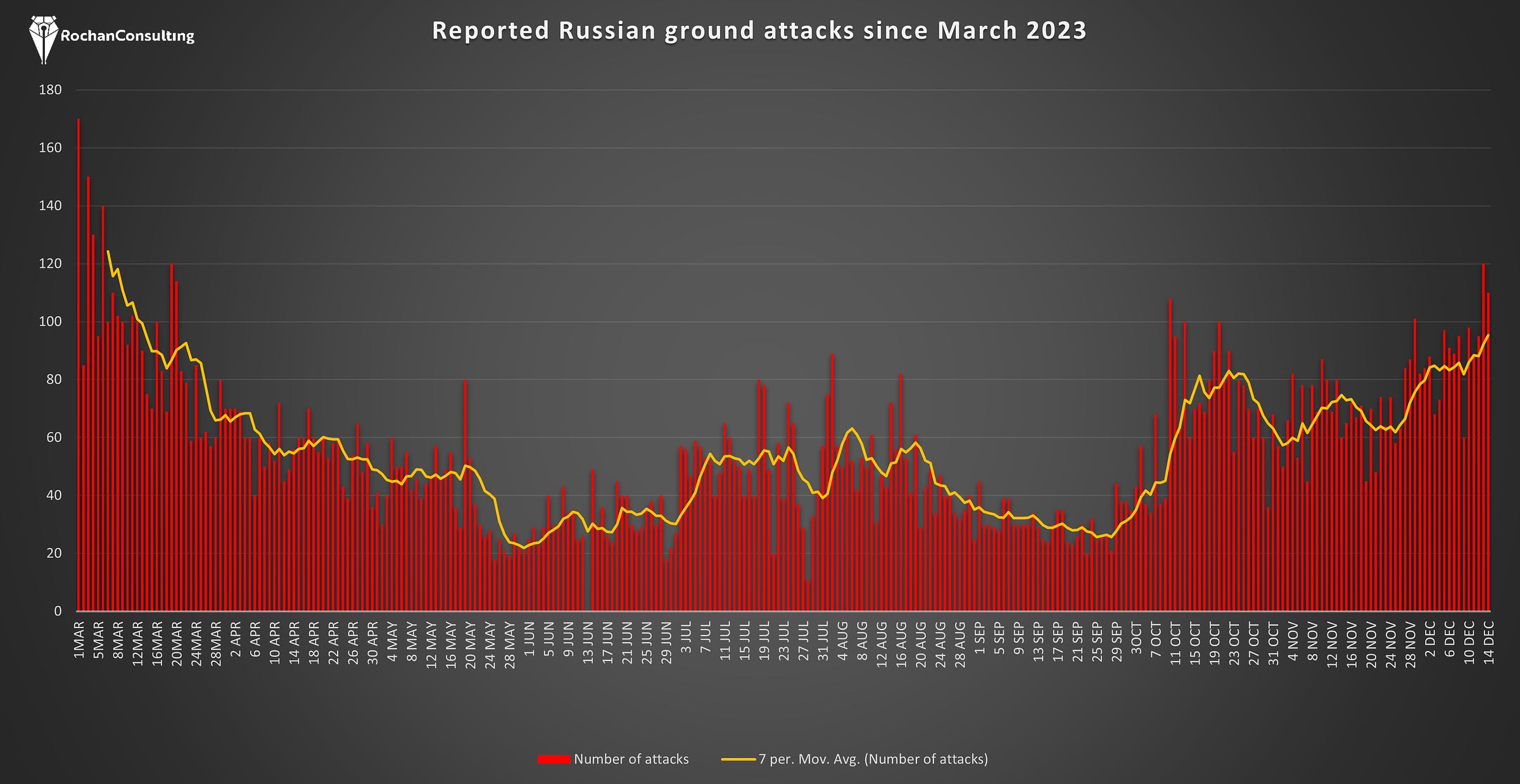
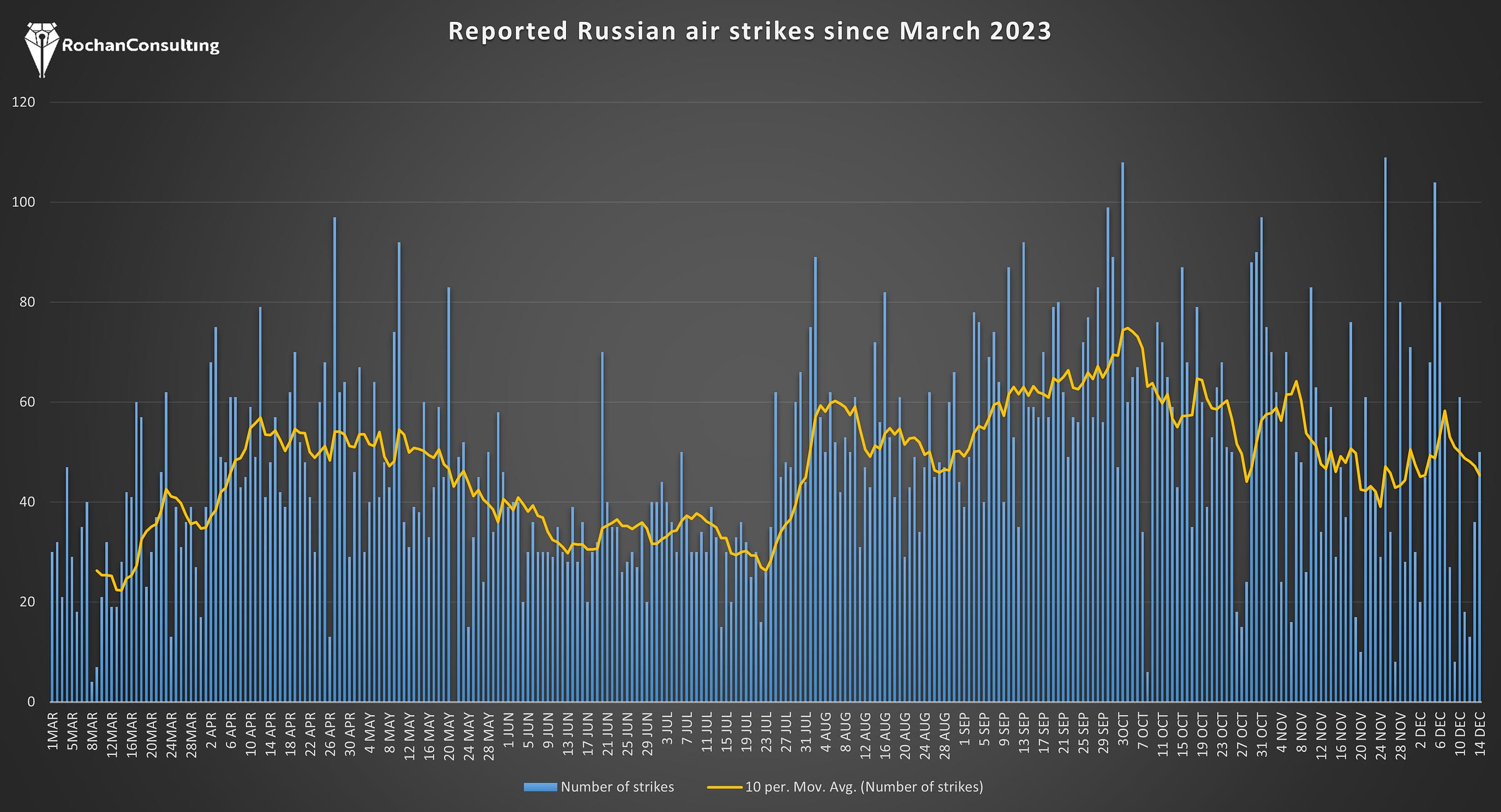
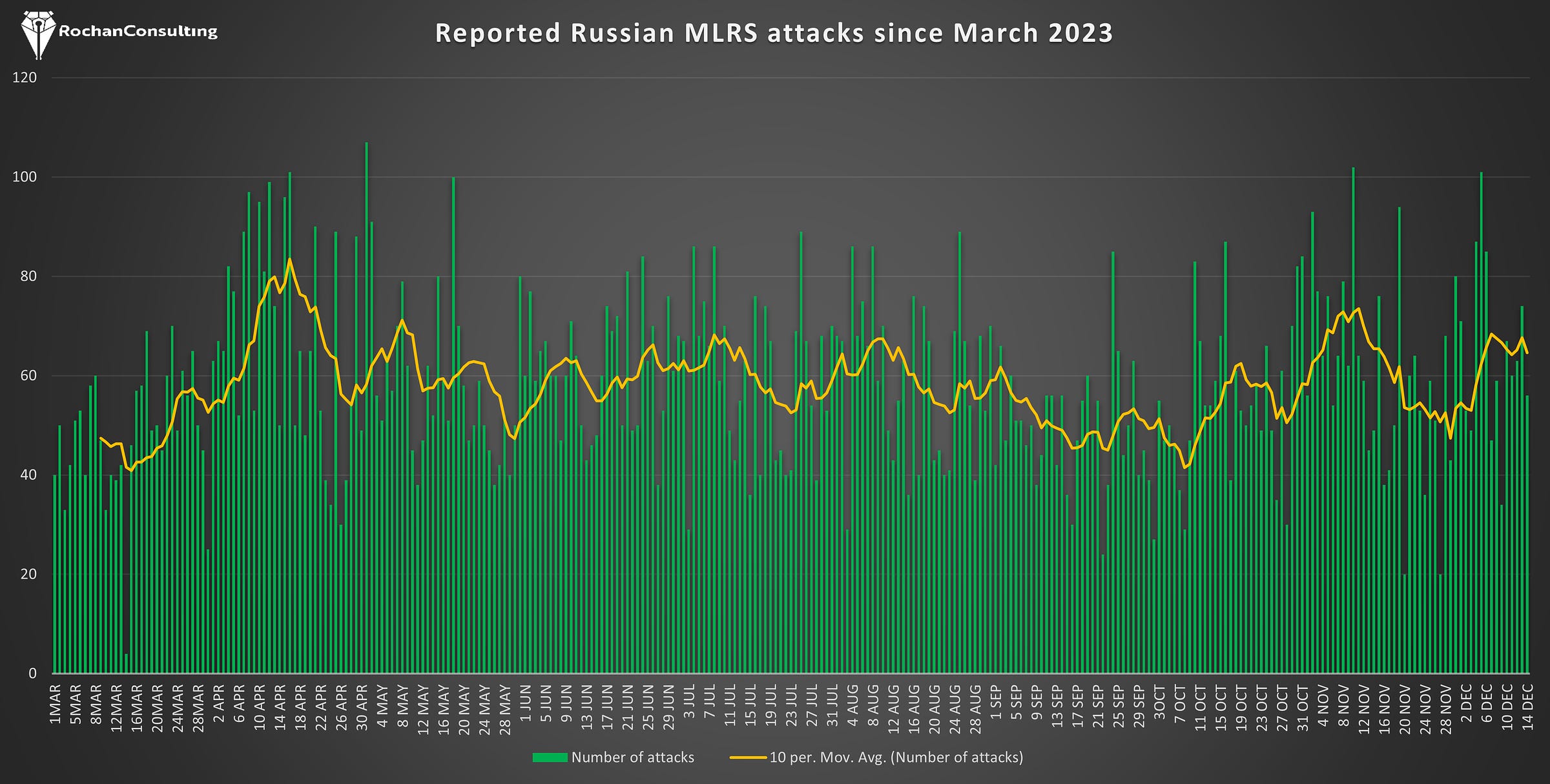
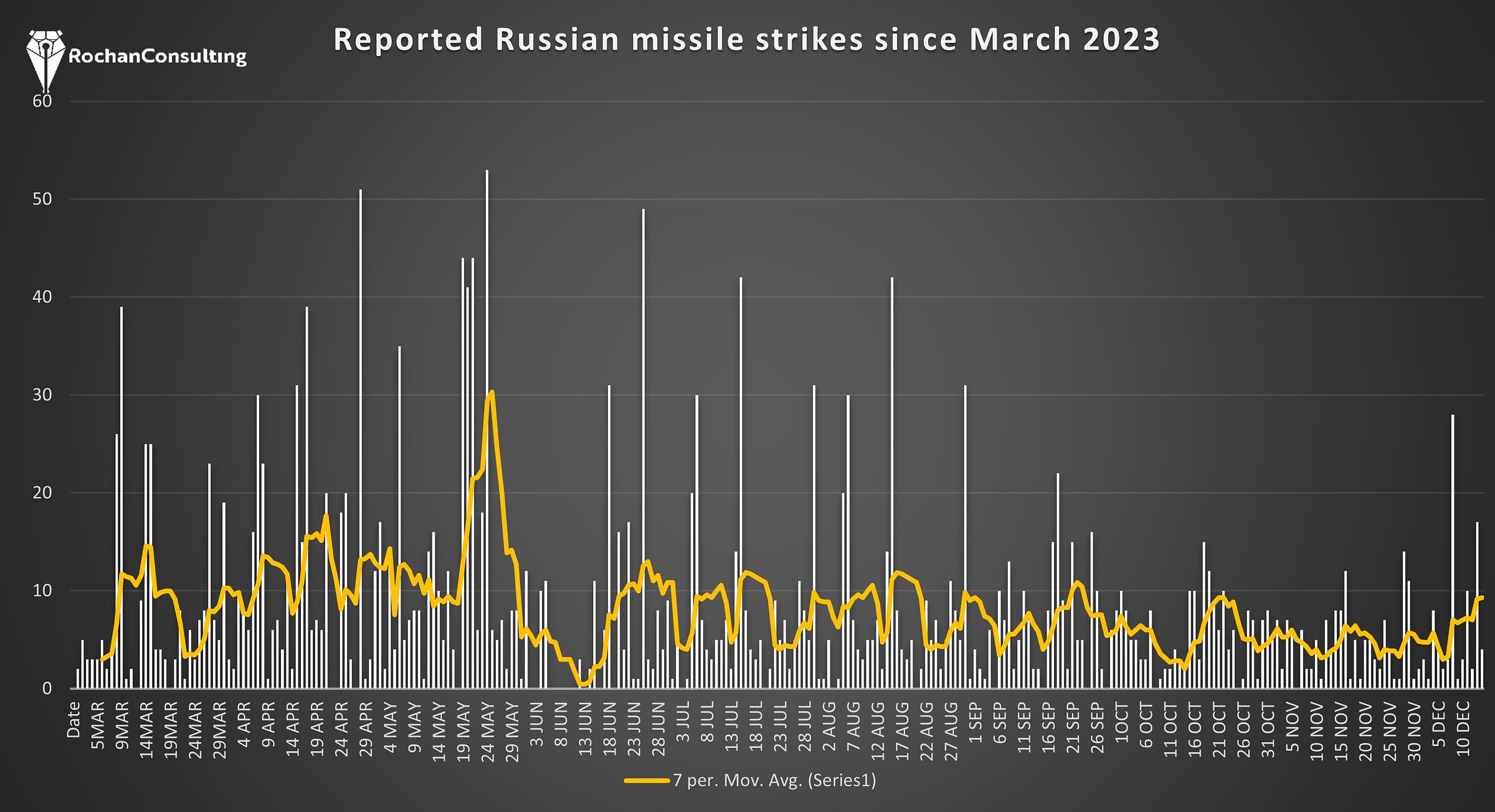
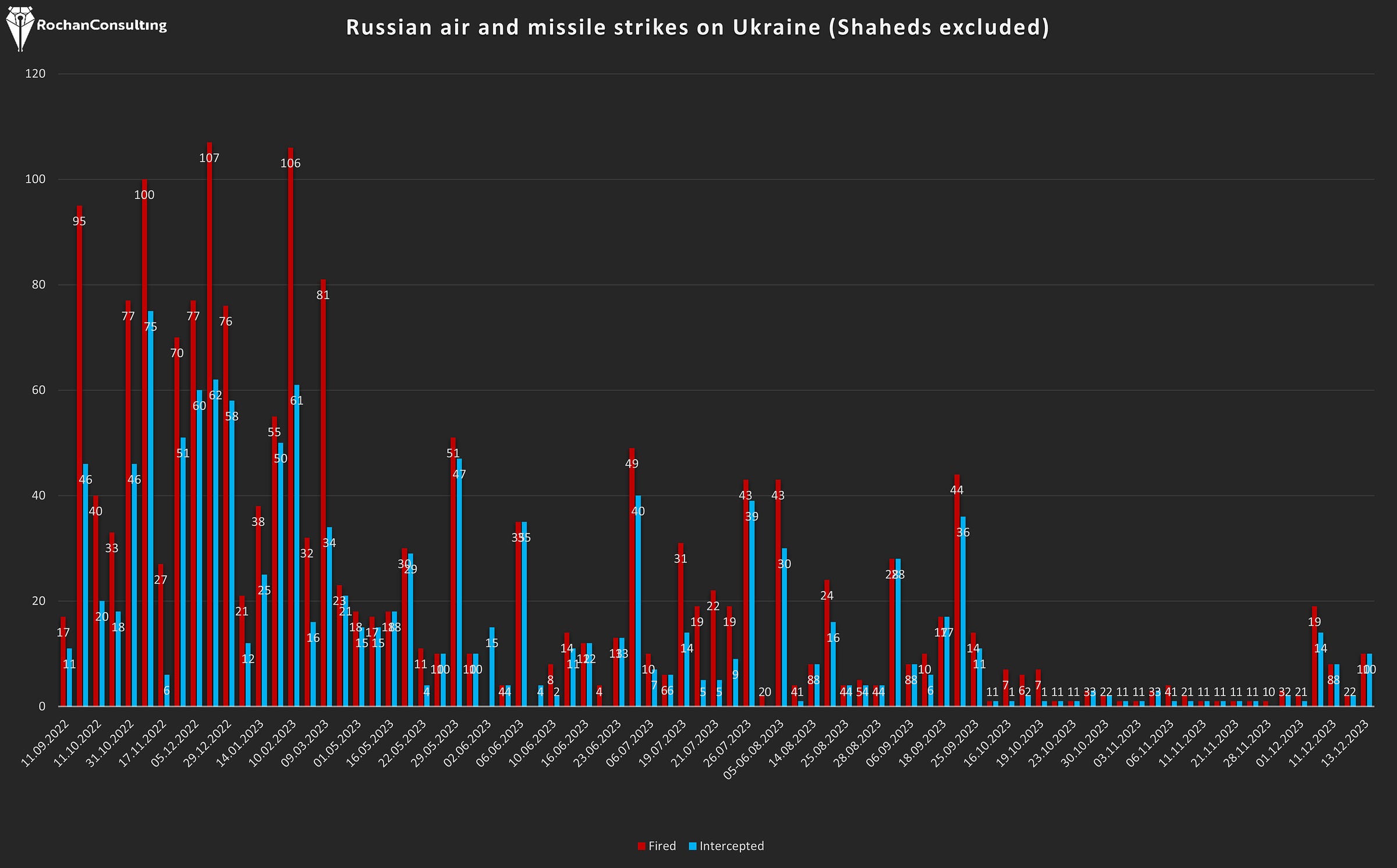

Outlook for the week of 16DEC-22DEC2023
In assessing the probability or likelihood of certain events, we use a set of terms proposed by the US Intelligence Community.
To introduce more accountability to our forecasts, each weekly update assesses how correct (or incorrect) our predictions were. Please also remember that while we try to remain as objective as possible regarding our performance, the reader will ultimately have to decide how (in)accurate we have been.
Previous forecast
“Regarding the Kharkiv Oblast Direction, we continue to expect no frontline changes. There is a small possibility that Russians will conduct cross-border raids, but they will certainly continue (no change) conducting artillery attacks on civilian areas across the region. Russian cross-border infiltration operations are also certain to continue.” This assessment was correct.
Score: 1/1
“When it comes to the Luhansk Oblast Direction, we maintain that Russian ground attacks in the Kupyansk axis are highly likely (no change) to continue. It is unlikely (no change) that they will capture one village or more. We continue to expect no Ukrainian gains in the region.” This assessment was also correct. Russians made no confirmed gains in the region.
“When it comes to the Donetsk Oblast, we are no longer assessing the probability of Ukrainian advances, which we consider to be presently non-existent. We maintain that Russians are highly likely to capture some terrain (no change) in both the Avdiivka and Bachmut axes, but we assess that they are unlikely to capture a village or more in the region.” Russians made marginal gains in both areas and, as expected, did not capture a village or more.
“Moving onto the Southern Direction, we currently assess that chances are remote (no change) that Ukrainians will make any gains in the region. We assess changes are roughly even (increase in probability) that Russians will progress in the region (capture some terrain). Still, we assess they are unlikely to capture a village or more (new item to assess).” While we were correct to anticipate no Ukrainian progress, Russians made no confirmed gains either.
Score: 0.5/1
“In the Kherson Oblast, we assess that Ukrainians are highly likely (no change) to continue (ground) attacking Russian positions on Dnipro’s left bank and may deploy additional forces. It is unlikely (decrease in probability) that they will capture some land, and we assess that changes are remote (decrease in probability) that they will capture one village or more.” This assessment was correct. The frontline did not change in the Kherson Oblast.
Score: 1/1
Final score: 4.5/5 (90%)
The forecast for the week of 16DEC – 22DEC2023
In parenthesis, we indicate a probability change compared to the previous assessment.
Regarding the Kharkiv Oblast Direction, we continue to expect no frontline changes. There is a small possibility that Russians will conduct cross-border raids, but they will certainly continue (no change) conducting artillery attacks on civilian areas across the region. Russian cross-border infiltration operations are also certain to continue.
When it comes to the Luhansk Oblast Direction, we maintain that Russian ground attacks in the Kupyansk axis are highly likely (no change) to continue. It is unlikely (no change) that they will capture one village or more. We continue to expect no Ukrainian gains in the region.
When it comes to the Donetsk Oblast, we are no longer assessing the probability of Ukrainian advances, which we consider to be presently non-existent. We maintain that Russians are highly likely to capture some terrain (no change) in both the Avdiivka and Bachmut axes, but we assess that they are unlikely to capture a village or more in the region.
Moving onto the Southern Direction, we currently assess that chances are remote (no change) that Ukrainians will make any gains in the region. We assess changes are roughly even (no change) that Russians will progress in the region (capture some terrain). Still, we assess they are unlikely to capture a village or more (no change).
In the Kherson Oblast, we assess that Ukrainians are highly likely (no change) to continue (ground) attacking Russian positions on Dnipro’s left bank and may deploy additional forces. It is highly unlikely (decrease in probability) that they will capture some land, and we assess that changes are remote (no change) that they will capture one village or more.





